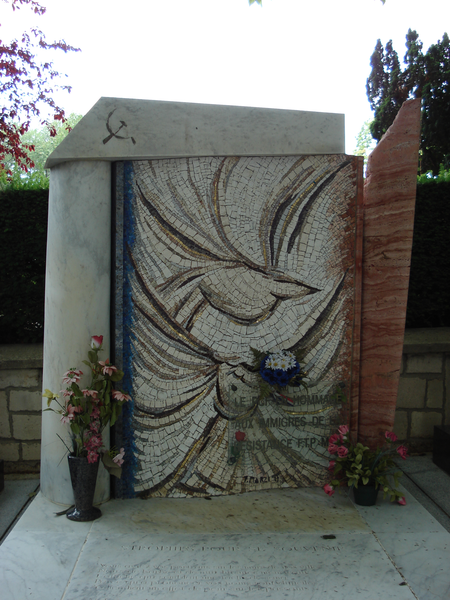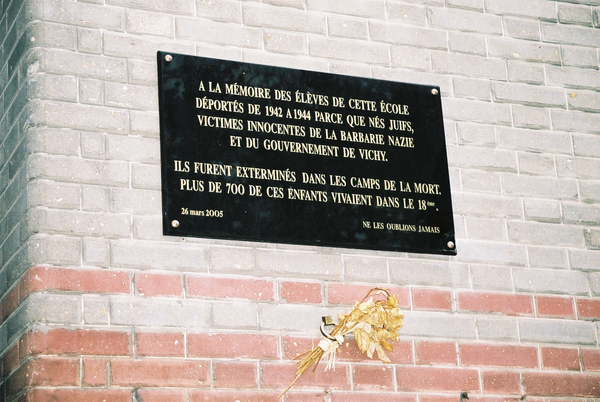Browse by Tags: memory
 | Up a level |
Number of items: 12.
Back to Basque
Shared with the University by Mr Jose Velazquez
Dr. Dacia Viejo-Rose in conversation with artist Tracey Moberly. Presentation of a multi-platform art project initiated by Spain NOW!, visual artist Tracey Moberly and Dr. Dacia Viejo-Rose, University of Cambridge. This project will look at the formation of identity, memory and displacement and commenced in autumn 2013. It is expected that the first results of the three-year-long project will be showcased at Spain NOW! 2014.
Shared with the University by Mr Jose Velazquez

France in Africa
Shared with the World by Prof Tony Chafer
A selection of resources built around the theme of the French presence in Africa
Shared with the World by Prof Tony Chafer

France in Sub-Sahara Africa
Shared with the World by Mr Emmanuel Godin
This collection contains original documents, academic texts and bibliographical references related to France and in its former Sub-Sahara African colonies.
Shared with the World by Mr Emmanuel Godin
Immigrants contribution to the Resistance in France during WWII.
Shared with the World by Mr Emmanuel Godin
Robert Guédiguian’s film Army of crime (2009) should be understood in the context of contemporary debates about French national identity and the contribution of immigrants to French society (see interview with the lead actor,Simon Abkarian). The film throws light on the role played iby anti-fascist refugees from Spain, Hungary, Poland, Armenia, Italy during the Second World War in France (See Official UK Trailer[Youtube]). These refugees, often Jews, close or members of the Communist Party, saw France as the country of human rights and were often the first one to organise resisters’ networks. Fighting in the Communist-led FTP-MOI (Francs-tireurs et partisans – main-d'œuvre immigrée), they were specifically targetted by the Nazis and the Vichy regime, as testified by the infamnous ‘Affiche rouge’. Poetry (Louis Aragon’s 1956 Strophes pour se souvenir) and mortuary monuments (such as the ones to be found in the Pére Lachaise cimetry in Paris, commemorating the role of Spaniards and immigrants in the Resistance movements),have been the traditional media through which their memory has been commemorated. Recently, Toulouse, ‘capital of Spanish republican exile’, has set up a ‘remembrance tour’ of the city. The Ciy Council has produced a (touristic?) leaflet to guide visitors through the major sites of Spanish Resistance (included here). A short bibliography points to the way academic research has also approached the subject.
Shared with the World by Mr Emmanuel Godin
Maqam el-chahid (Algiers), War memorial
Shared with the World by Mr Emmanuel Godin
Dominating the Algiers skyline is Maqam el-chahid (monument to the martyr), inaugurated in 1982 (under Chadli Bendjedid's presidency) to commemorate the twentieth anniversary of independence. Three enormous palmettes stretch 97 metres high, at the foot of each, three statutes are said to symbolise the three pillars of the proclaimed revolution, cultural, industrial and agrarian - although they are all armed men.
Shared with the World by Mr Emmanuel Godin
President Chirac's (1995-2007) stance on the Vichy regime and antisemitism.
Shared with the World by Mr Emmanuel Godin
After President Chirac's official recognition (1995) that France actively participated in deportation of Jews, commemorative plaques were erected on the wall of each Parisian school stipulating the number of children who had been deported in each 'arrondissement'. (Here a plaque in the XVIII arrondissement, from which more than 700 Jewish children were rounded up by the French police before being deported). Chirac's 1995 discourse (here included in French) about the responsibility of the French state in the deportation of Jews marked a departure from the previous Gaullist orthodoxy. On the occasion of the official opening of the new exhibition in the French pavilion of the Auschwitz-Birkenau Memorial and Museum in January 2005, President Chirac reflected on the impact of the Holocaust on France (text in English). A few days before, President Chirac inaugurated the 'Memorial de la Shoah' in the IV arrondissement of Paris. Just outside the Memorial, 'Le Mur des Justes' (Righteous among the Nations) commemorates the French people who risked their lives to save Jews from extermination during the Occupation (6 photos included). Facing the 'Murs des Justes', in a street recently remaned 'Allée des Justes', a commemorative plaque adornes the door of the local secondary school (College Frederic Couperin, Photo included. It reminds passers-by that out of the 11,000 Jewish children arrested by the Vichy police in France between 1942 and 1944, 500 came from the 4th arrondissement of Paris. They were deported to Auschwitz.
A Weblink to the INA site (Institut National de l'Audiovisuel) will enable visitors to see how the French television channel France 2 covered the event. This resource also includes a link to the Memorial de la Shoah in Paris, a site which provides invaluable resources (see in particular its 'Centre de Documentation Juive Contemporaine'.
Students with a good understanding of postwar politics and history may want to use these sources to explain why Chirac broke from the postwar Gaullist narrative.
Shared with the World by Mr Emmanuel Godin
Remembering the Colonial Past in France and Africa
Shared with the World by Mr Emmanuel Godin
Once France’s sub-Saharan African colonies became independent in 1960, African troops who had served France loyally both in the world wars and in its wars of decolonization did not fit easily into the official, nationalist narrative of postcolonial African leaders of an African nation united in the struggle against French colonialism. As a result their role and experiences were largely ‘forgotten’ for some forty years after independence. A powerful symbol of this official forgetting is that, as recently as 1999, in France’s oldest African colony Senegal, a French colonial monument originally cast in 1923 to commemorate the role played by African soldiers fighting for France in World War I, was removed to a small cemetery on the outskirts of Dakar because its presence in the centre of the city was considered too redolent of the country’s colonial past. Yet five years later the monument made a great comeback to the city centre after the announcement by the President Wade, in the presence of a plethora of African heads of state of former French colonies, of the creation of a national day to commemorate the tirailleurs. At the same time he also announced that the Senegalese government would henceforth pay an allowance to all Senegalese war veterans still alive on 2 March 2000, in addition to the increase in African war veterans’ pensions recently announced by France. Following this the monument was restored to the centre of the city to become the focal point of a vast commemoration project in which the Place de la Gare was renamed the Place du Tirailleur and designated as a memorial to African soldiers who perished in both world wars.
Shared with the World by Mr Emmanuel Godin
Representations of Childhood and Violence in Recent Films depicting the Algerian War: using cinema to locate conflicting memories.
Shared with the World by Mr Emmanuel Godin
Dr Joseph McGonagle, Lecturer in Cultural Studies in the French Speaking World, University of Manchester answers questions on key themes in filmic representations of Franco-Algerian relations, the advantages and pitfalls of using film to help students understand historical and contemporary Franco-Algerian relations(interview carried out by Natalya Vince, March 2009). The 12 minute interview took place just after the one-day conference on 'France, North Africa and the Middle East
Interdisciplinary and Multimedia Perspectives', held at the University of Portsmouth on 18 March 2009. 1. What are some of the key themes in films that represent Franco-Algerian relations?
2. What are some of the advantages and some of the pitfalls of using films as a tool to help students to understand contemporaries or Franco-Algerian relations?
3. Do you think students are able to place their understanding of films in context of the real world? Do you think there’s a danger of over –interpretation?
4. Which 3 films would you choose which are most useful for students to study?
Shared with the World by Mr Emmanuel Godin
Tirailleurs Sénégalais and the First Word War: memory and commemoration
Shared with the World by Mr Emmanuel Godin
This resource includes a reproduction of a 1923 monument commemmorating the Tirailleurs Sénégalais who fought for France during the First World War. The original of this monument was erected in Reims and destroyed by the Germans in 1940. An exact copy used to be displayed in Bamako (Mali) but is not currently on public display. This small-scale reproduction may be viewed at the Musée des Forces Armées in Dakar (Senegal)
This resource also includes the reproduction of a certificate awarded to a Tirailleurs Sénégalais batallion, in recognition of its bravery in battle during the First World War.
The website: www.tirailleursenegalais.com, is very interesting in the way that it rehabilitates the tirailleurs into a national narrative ('batisseurs du monde libre') but of course completely glosses over the fact that many tirailleurs also fought for France in its two wars of decolonisation in Indochina and Algeria.
Shared with the World by Mr Emmanuel Godin
To be a moudjahida in independent Algeria
Shared with the World by Mr Emmanuel Godin
In her thesis‘To be a moudjahida in independent Algeria: itineraries and memories of women veterans of the Algerian War of Independence’ (University of London, 2008 under the supervision of Professor Julian Jackson), Natalya Vince provides a new examination of the diverse experiences of Algerian women during the War of Independence. It is the first study to analyse female veterans’ itineraries in the post-war period, investigating their status in contemporary Algerian society and their place in collective memories at national, local and familial levels. As such, it provides counterbalance to the popular and scholarly consensus that after the war women, willingly or not ‘went back into the kitchen’. The research incorporates extensive oral interviews with 30 female veterans, unexploited primary documents from Algerian, French and British archives and a survey of 95 students at a teacher training college in Algiers on their attitudes towards the war, veterans, the teaching of history and the transmission of memory. Using oral history challenges the monolithic, top-down treatment that has dominated historiography of the Algerian War, highlighting the importance of gender, socio-economic circumstances and locality in determining wartime and post-war experiences. The case study at the teacher training college in particular highlighted continuing shifts in interpretations of the war. Many students of this generation, born at the same time as the upsurge of Islamism in Algeria, framed the War of Independence as a holy war, employing a religiously-impregnated language which is not that of their elders. Here is an extract from an interview with an FLN nurse, carried out by Natalya Vince in Algiers in December 2005.
Shared with the World by Mr Emmanuel Godin
War of Ghosts
Shared with the World by Mr Bob Wilkinson
Useful for undergraduates of Linguistics, and Psycholinguistics. This is a classic text used by Frederick Bartlett in his research into memory.
Shared with the World by Mr Bob Wilkinson
‘Empty Spaces and the Value of Symbols: Estonia’s ‘War on Monuments’ from Another Angle’
Shared with the World by Ms Claire Monaghan
Powerpoint presentation - Identity, memory and landscape: a case study of Estonia. This was originally devised as a conference presentation, but has since been used for teaching purposes, on a summer school in Estonia in July 2009 and on an MSc course in Glasgow. The Powerpoint supported a workshop format, where students were invited to reflect on the various images in groups.
Shared with the World by Ms Claire Monaghan
![[img]](http://www.humbox.ac.uk//542/1.hassmallThumbnailVersion/History_and_memory_France_resistance_Immigration_Communist_Party.jpg)

![[img]](http://www.humbox.ac.uk//548/1.hassmallThumbnailVersion/Histroy_and_memory_France_Paris_antisemitism_deporation_school.jpg)



